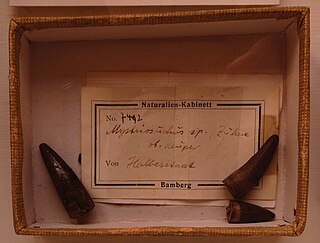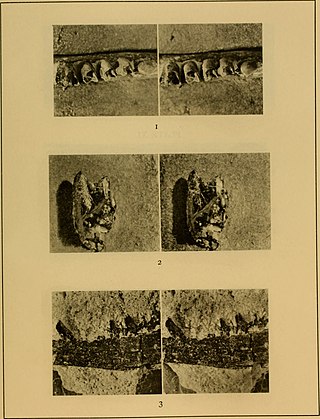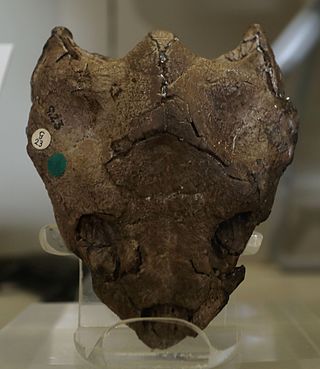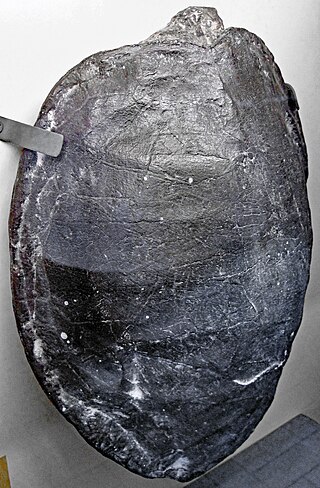| Strassfurt Formation | |
|---|---|
| Stratigraphic range: Permian | |
| Type | Formation |
| Location | |
| Country | Germany |
The Stassfurt Formation is a geologic formation in Germany. It preserves fossils dating back to the Permian period.

Belodon is a genus of phytosaur, a crocodile-like reptile that lived during the Triassic. Its fossils have been found in Europe and elsewhere. The type species, Belodon plieningeri, was named by prolific German paleontologist Christian Erich Hermann von Meyer in 1844.

Docodon is an extinct docodont mammaliaform from the Late Jurassic of western North America. It was the first docodont to be named.

Eoenantiornis is a genus of enantiornithean birds which lived during the early Cretaceous period. It is known from a single fossil specimen found in the Yixian Formation in Liaoning province, China.

Anarosaurus is an extinct genus of pachypleurosaurs that lived in the Middle Triassic period (Anisian) and has been found in the Jena Formation and the Karlstadt Formation of Germany and the Winterswijk Quarry of The Netherlands. Two species are known: A. pumilio and A. heterodontus. The holotype of A. pumilio was originally housed at the Institut und Museum fur Geologie und Palaontologie, Georg-August-Universitat, Gottingen, but can no longer be located today because it was lost or destroyed during World War II. Anarosaurus was a small reptile with an estimated body length of 50–60 cm (1.6–2.0 ft).
Ferganoceratodus is a genus of prehistoric lungfish known from the Mesozoic of Asia. Based on morphological evidence, it has either been recovered as a basal member of the Ceratodontiformes or to be the sister group of the Neoceratodontidae.

Seeleyosaurus is an extinct genus of plesiosaur that was initially placed within the genus Plesiosaurus in 1895 and was given its own genus in 1940. Two species were known: the type, S. guilelmiimperatoris, and the now obsolete species S. holzmadensis, which has since been absorbed into S. guilelmiimperatoris. It was a relatively small plesiosaur, measuring 2.9–3.6 m (9.5–11.8 ft) long. The holotype is MB.R.1992, a large almost complete skeleton from the Upper Lias (Toarcian) Lias Group Formations of Württemberg, Germany. There seems to be the impression of a rhomboidal flap of skin in a vertical plane; if so, many plesiosaurs may have been equipped in this way. A second specimen, preserved in 3D, is the holotype of S. holzmadensis.
Serrolepis is an extinct genus of prehistoric bony fish that lived during the Ladinian age of the Middle Triassic epoch in what is now Baden-Württemberg, Germany.
Amblotherium is an extinct genus of Late Jurassic and Early Cretaceous mammal. The type species Amblotherium pusillum is from the Lulworth Formation of southern England, while the referred species Amblotherium gracile is from stratigraphic zones 2, 3 and 5 of the Morrison Formation of the US.

Laolestes is an extinct genus of dryolestid mammal. Fossil remains are known from the Morrison Formation, in stratigraphic zones 5 and 6., the Late Jurassic of Portugal, and Early Cretaceous Wadhurst Clay of the United Kingdom.

Dorsetochelys is an extinct genus of turtle from the Early Cretaceous of southern England and northwestern Germany.

Dinochelys is an extinct genus of paracryptodiran turtle from the Late Jurassic Morrison Formation.
Meyerosuchus is an extinct genus of mastodonsauroidean temnospondyl. Fossils have been found from the Early Triassic Hardegsen Formation in southern Germany. Meyerosuchus is present in late Olenekian deposits of the Middle Buntsandstein. The type species M. fuerstenberganus was named in 1966, although remains have been known since 1855. Meyerosuchus is closely related to Stenotosaurus; both genera are grouped in the family Stenotosauridae and the two genera may even be synonymous.
Tambaroter is an extinct genus of ostodolepid microsaur from the Early Permian of Germany. The type species T. carrolli was named in 2011. Tambaroter is known from a single skull found in the Tambach Formation, which is the lowermost unit of the Upper Rotliegend. It is the only vertebrate that has been found outside the Bromacker Quarry, the most productive locality of the formation. It is also the first ostodolepid known from outside North America.
Palatinerpeton is an extinct genus of temnospondyl amphibian. Fossils have been found in the Lauterecken-Odernheim Formation of Germany.
The Whiteaves Formation is a geologic formation in British Columbia. It preserves fossils dating back to the Jurassic period.
The Rögling Formation is a geologic formation in Germany. It preserves fossils dating back to the Jurassic period.

The Messel Formation is a geologic formation in Hesse, central Germany, dating back to the Eocene epoch. Its geographic range is restricted to the Messel pit. There it unconformably overlies crystalline Variscan basement and its Permian cover (Rotliegend) as well as Eocene volcanic breccias derived from the basement rocks. The formation mainly comprises lacustrine laminated bituminous shale renowned for its content of fossils in exceptional preservation, particularly plants, arthropods and vertebrates.
The Rott Formation is a geologic formation in Germany. It preserves fossils dating back to the Oligocene.
The Jena Formation is a geologic formation in Germany. It preserves fossils dating back to the Triassic period.

Tasbacka is an extinct genus of sea turtle containing several species.
{{cite web}}: |author= has generic name (help)